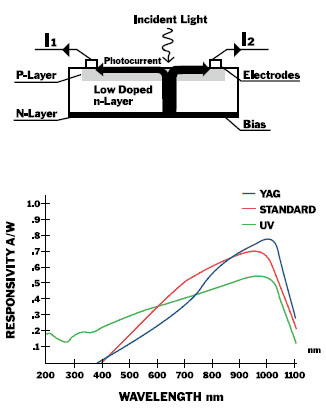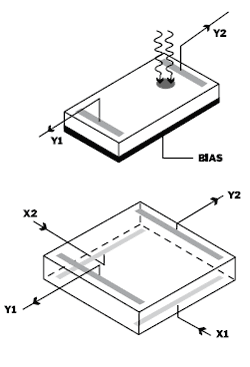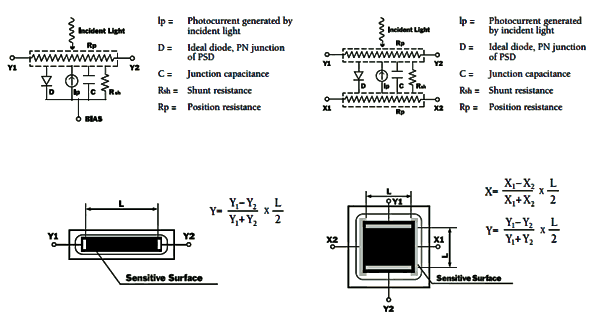PSD Theory
Position Sensing Detectors:

0.19 A/W @ 340 nm
0.76 A/W @ 1000 nm
Dead Layer
(5.5 MEV Alpha)
Description
Position Sensing Detectors "PSD's" are silicon photodiodes that provide an analog output directly proportional to the position of a light spot on the detector active area. The PSD allows you to simultaneously monitor position and light intensity. The PSD is a continuous analog position sensor. Compared to discrete element devices, the PSD offers outstanding position linearity, high analog resolution, fast response time, and simple operating circuits.
Theory Of Operation
A Position Sensing Detector consists of n-type silicon substrate with two resistive layers separated by a p-n junction. The front side has an ion implanted p-type resistive layer with two contacts at opposite ends. The back side has an ion implanted n-type resistive layer with two contacts at opposite ends placed orthogonally to the contacts on the front side. On a single axis PSD, the electrodes are placed at opposite ends of the p-type resistive layer. A light spot within the spectral range of silicon will generate a photocurrent that flows from the incident point through the resistive layers to the electrodes. The resistivity of the ion implanted layer is extremely uniform so the photogenerated current at each electrode is inversely proportional to the distance between the incident spot of light and electrodes. The PSD outputs track the motion of the "centroid of power density" to an extremely high resolution and ultra-high linearity. On-Trak Position Sensing Amplifiers take the photocurrent from each electrode and process the signals to provide X, Y outputs independent of light intensity.
Position Resolution
The position resolution of a PSD is the minimum detectable displacement of a spot of light on the detector surface. The position resolution of On-Trak PSDs are proven better than one part in a million. Resolution dependent on:
- Detector Size
- Detector Noise
- Light Input Intensity
- Bandwidth of the Electronic Signal Processing Circuits
Position Linearity
Position non-linearity is defined as geometric position error divided by detector length and is measured within 80% of the detector length. Position non-linearity is typically better than 0.05% for the single axis PSD and better than 0.3% for the duolateral. The On-Trak vs competitor two-dimensional linearity plot shows the ultra linear characteristic of these PSDs.

One-Dimensional PSD
The one-dimensional PSD detects a light spot moving over its surface in a single direction. The photoelectric current generated by the incident light flows through the device and is seen as an input bias current divided into two output currents. The distribution of the output currents show the light position on the detector.
Duolateral Two-Dimensional PSD
The duolateral two-dimensional PSD detects an incident light spot position on its square surface. The photoelectric current generated by the incident light flows through the device and is seen as two input currents and two output currents. The distribution of the output currents show the light position of one dimension (Y), and the distribution of the input currents show the light position of the second dimension (X).

